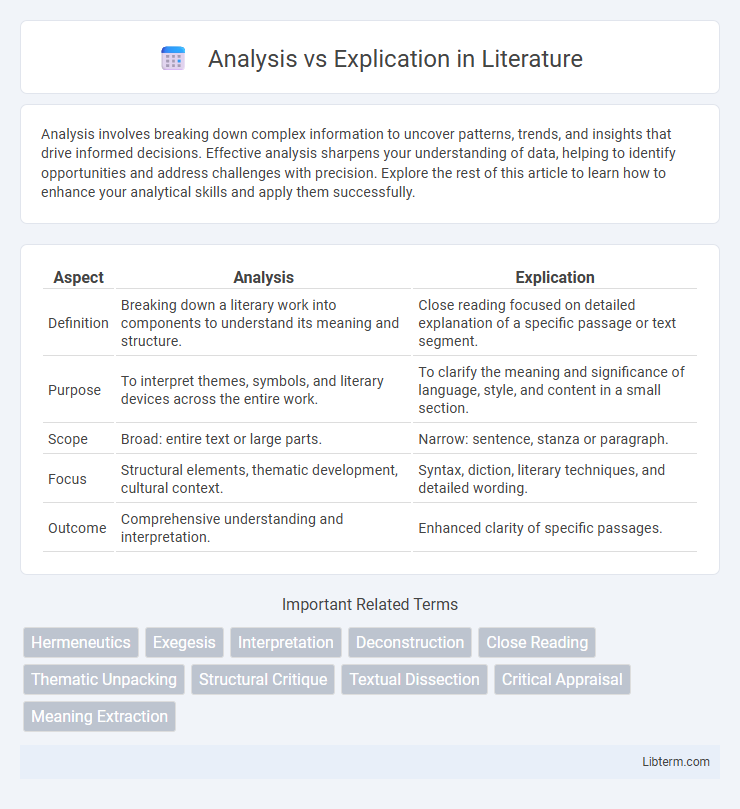Analysis involves breaking down complex information to uncover patterns, trends, and insights that drive informed decisions. Effective analysis sharpens your understanding of data, helping to identify opportunities and address challenges with precision. Explore the rest of this article to learn how to enhance your analytical skills and apply them successfully.
Table of Comparison
| Aspect | Analysis | Explication |
|---|---|---|
| Definition | Breaking down a literary work into components to understand its meaning and structure. | Close reading focused on detailed explanation of a specific passage or text segment. |
| Purpose | To interpret themes, symbols, and literary devices across the entire work. | To clarify the meaning and significance of language, style, and content in a small section. |
| Scope | Broad: entire text or large parts. | Narrow: sentence, stanza or paragraph. |
| Focus | Structural elements, thematic development, cultural context. | Syntax, diction, literary techniques, and detailed wording. |
| Outcome | Comprehensive understanding and interpretation. | Enhanced clarity of specific passages. |
Understanding Analysis and Explication
Understanding analysis involves breaking down a text or concept into its fundamental components to examine relationships and meanings systematically. Explication centers on clarifying and interpreting the deeper significance of a text through detailed explanation and contextual insights. Both methods enhance comprehension but analysis emphasizes structural dissection while explication prioritizes interpretive clarity.
Defining Analysis in Academic Writing
Analysis in academic writing involves breaking down complex ideas, texts, or data into smaller components to understand their meanings, relationships, and implications deeply. It requires critical thinking and evidence-based examination to interpret and explain how individual elements contribute to the overall message or argument. Effective analysis goes beyond summarizing by offering insights that reveal underlying patterns, themes, or assumptions within the subject matter.
The Essence of Explication
Explication delves deeply into uncovering the intrinsic meaning and underlying intentions within a text, emphasizing nuanced interpretation beyond surface-level comprehension. Unlike analysis, which breaks down elements systematically, explication seeks to illuminate the holistic significance and subtle emotional or thematic resonances embedded by the author. This process reveals the essence of explication as a method of intimate engagement that bridges textual detail with broader interpretive insight.
Key Differences Between Analysis and Explication
Analysis involves breaking down a text or concept into its fundamental components to understand its structure, meaning, and purpose, while explication focuses on a detailed interpretation of specific parts or passages, clarifying meaning and nuances. Analysis emphasizes logical examination and critical thinking, often incorporating broader context, whereas explication prioritizes close reading, linguistic features, and rhetorical devices within the text. Key differences lie in the scope--analysis is comprehensive and synthetic, whereas explication is focused and interpretative, offering deep insight into particular elements.
Purpose and Objectives of Each Approach
Analysis aims to break down a text or concept into its fundamental components to understand structure, meaning, and relationships within. Explication focuses on providing a detailed, line-by-line interpretation to clarify nuances, context, and deeper significance. While analysis seeks to identify patterns and underlying frameworks, explication emphasizes thorough explanation and precise meaning extraction.
Techniques for Effective Analysis
Effective analysis employs techniques such as critical reading, identifying patterns, and contextualizing information to uncover deeper meanings within texts. Utilizing evidence-based reasoning and thematic categorization enhances the clarity and precision of analytical interpretations. Techniques like comparative evaluation and structural breakdown facilitate a comprehensive understanding of complex materials.
Strategies for Clear Explication
Effective strategies for clear explication emphasize presenting detailed, step-by-step interpretations to reveal underlying meanings in texts or concepts. Using precise examples and context-specific explanations enhances comprehension and avoids ambiguity. Clarity is further ensured by organizing ideas logically and maintaining a focus on the text's key elements rather than broad summaries or subjective opinions.
Common Mistakes to Avoid
Analysis often gets confused with explication, but analysis involves breaking down a text into components to understand its structure, while explication focuses on detailed explanation of meaning and context. A common mistake is treating explication as mere summary, which neglects deeper interpretation, or misunderstanding analysis as only surface-level observation without connecting elements. Avoid these errors by emphasizing critical thinking in analysis and thorough contextual insight in explication.
When to Use Analysis vs. Explication
Analysis is best used when examining complex works or data sets to uncover underlying patterns, themes, or causes, often requiring a detailed breakdown of components. Explication suits situations needing a line-by-line or phrase-by-phrase interpretation, especially in literary texts, to clarify meaning and reveal nuanced language features. Choose analysis for broader critical insight and explication for precise textual understanding.
Integrating Both Methods in Your Writing
Integrating analysis and explication in your writing enhances clarity and depth by combining objective examination of evidence with detailed interpretation of meaning. Analysis focuses on breaking down complex ideas and supporting arguments with evidence, while explication unpacks the nuances of language and context to reveal deeper significance. Utilizing both methods allows for a comprehensive approach that effectively communicates insight and supports critical thinking in academic and literary texts.
Analysis Infographic

 libterm.com
libterm.com